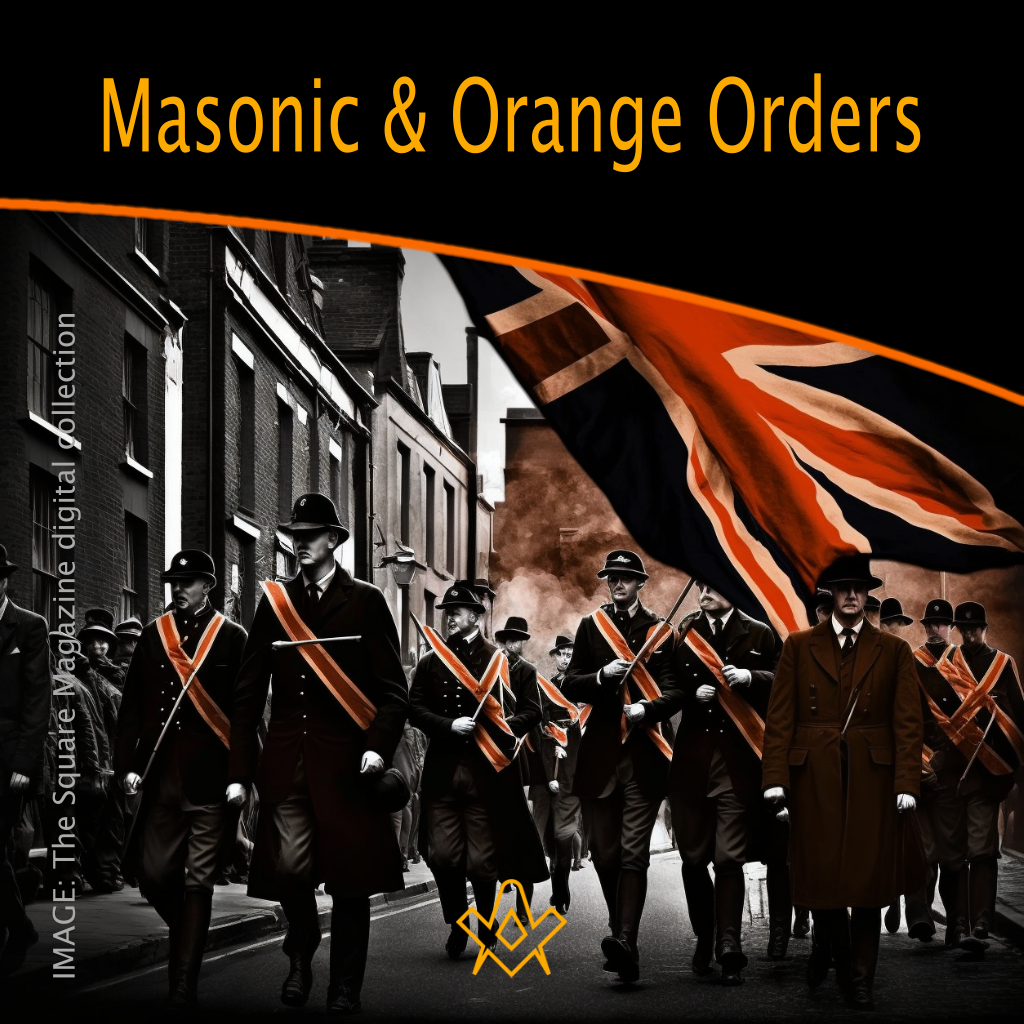The masonic and orange orders: fraternal twins or public misperception? “Who’s the Mason in the black?”
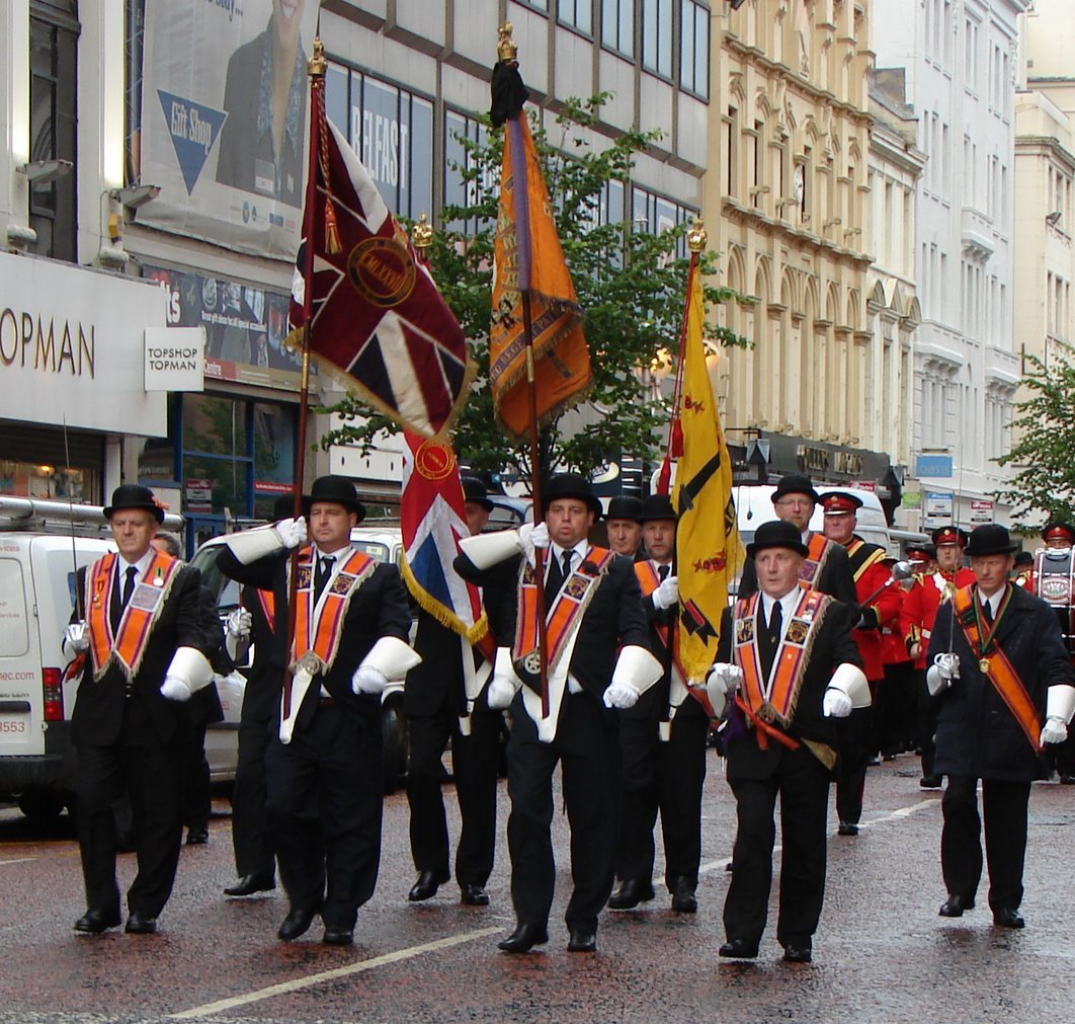
Thiepval Memorial Lodge in Belfast, 2 July 2007. Photograph copyright Helen Robinson, 2007 CC BY-SA 3.0 – By The original uploader was Helenalex
IMAGE LINKED: wikimedia Attribution 4.0 International (CC BY 4.0)
“Who’s the Mason in the black?” shout the supporters of any football side (or soccer side for American readers) when the match referee awards what in their minds is a dubious decision in favour of the Scottish Premiere League team Rangers Football Club.
Why “Mason in the black?” Apart from the fact referees once invariably dressed in black, there is a feeling abroad amongst supporters of other football clubs, that most football referees in Scotland are Freemasons; and as such, must naturally favour Rangers, because both are often perceived to be staunchly Protestant in their affiliations.
For a good number of years, Rangers have been striving to fend off the suggestion—which has been tabloid currency for many years, that they are a pro-Protestant, anti-Roman Catholic club, who are bigoted and discriminatory towards persons who profess the latter faith.
There is little doubt that Rangers—for the larger part of their history— have not hidden their firm Protestant Unionist credentials; since their birth as a fledgling football club known as ‘The Gallant Pioneers’ in 1872.
The team traditionally play in the red, white, and blue colours of the Union flag, and an anti-Catholic bias had the tacit—if not overt approval— of those associated with the club for many years.
In 1912, Glasgow merchant Sir John Ure Primrose (1847–1924) became chairman of the club.
He was a fervent Unionist, staunchly anti-Catholic, and publicly allied Rangers to the Masonic / Orange cause.
He also saw his club’s rivalry with Celtic as a money-making enterprise, and sectarianism catered to a large niche market. [1]
Efforts to curb sectarian chanting by their supporters, is something the club has addressed on an ongoing basis; often with mixed results, their minds increasingly focused on the problem, due to pressure brought to bear by the Union of European Football Associations (UEFA) in the latter’s crackdown on sectarianism in football.
Rangers great and bitter rivals are of course Celtic Football Club which has a strong Irish Republican, Roman Catholic tradition, stemming from the fact the club was formed by Irish Marist Priest, Brother Walfrid (Andrew Kearns) in 1888, and for whom a statue now stands proudly outside Celtic Park. [2]
The supporters of Celtic proudly emphasise their tradition by singing patriotic Irish songs and waving the Irish tricolour at matches.
Notwithstanding, Celtic Football Club seemed to have more of a pro-Catholic bias as opposed to an anti-Protestant one, as evidenced by the number of Protestants who have played for them over the years; and of course, their most famous and successful manager was the great Jock Stein, who was a Protestant and Freemason. [3]
In fairness, it also has to be said that Rangers have publicly employed Roman Catholic players and staff in recent years.
Nevertheless, both sides have had sectarian elements attached to them throughout their history, some of whom not only sing the praises of paramilitary organisations which existed during the political troubles in Northern Ireland, but have been members of these organisations, or have supported them financially.
Rangers supporters not only sang the praises of King William of Orange and his famous defeat of Catholic King James II at the Battle of the Boyne in 1690, but likewise for the various paramilitary Loyalist groups in Northern Ireland.
At the same time, Celtic supporters extolled the dubious virtues of Republican paramilitaries.
Where does Freemasonry come into this? Well, the fact is it does not, or should not. In order to become a mainstream Freemason, a candidate is required to profess a belief in a supreme being. He has to be at least 21 years of age, free, and of good character.
On that basis, good men of any religion can become Freemasons—and do. There are Protestant, Roman Catholic, Jewish, Muslim, and Hindu Freemasons who all meet harmoniously within a Masonic Lodge.
The chant “Who’s the Mason in the black?” is therefore a misnomer, and leads to confusion for members of the public.
Why is it that the public believe Freemasonry to be an exclusively Protestant organisation, with a bias against Roman Catholics?
It is very simply because in the mind of many of them, Freemasonry is synonymous with Orangeism.
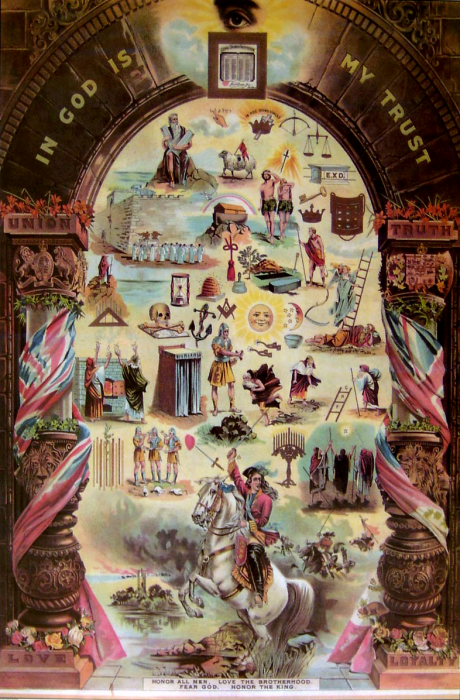
Orange Order poster depicting historical and religious symbols. By Aughavey at English Wikipedia – Transferred from en.wikipedia to Commons by Jhamez84.
IMAGE LINKED: wikimedia Attribution 4.0 International (CC BY 4.0)
Many people believe Orangeism to be a shady, invidious ideal, and one can see why this might be.
The Orange Order is an unashamedly sectarian organisation; only Protestants can join the Order, and the main aim of the Order is to defend and preserve Protestantism as the dominant religion of their country.
They swear to defend the faith, particularly against papal encroachment, which they deem contrary to their core beliefs.
Moreover, there has always been juxtaposition between some members of the Orange Order and Loyalist paramilitary groups.
Notwithstanding, the Orange Order is a lawful organisation, and the leaders of it point to the fact they are not anti-Catholic, but pro-Protestant; and that their beef, if they have one, is not with Roman Catholics as individuals, but the papal hierarchy- both in the way they choose to practice the worship of God, and their social and political ambitions.
However, this does not explain why the public believe that Freemasons and Orangemen are cut from the same cloth.
Although Freemasonry and Orangeism are two totally distinct Orders, that are not in amity or affiliated in any way, they do share a common history; and it is known that many men simultaneously enjoy membership of both organisations.
The Orange Order came into existence in Northern Ireland in 1795; it is not the purpose of this paper to discuss the long and bloody history of Ireland and only a brief synopsis is required here concerning the origins of the Order.
In the 17th and 18th century in Ireland, there were many local conflicts between Catholics and Protestants concerning the ownership of land, which occasionally boiled over into violence. This led to the formation of a number of secret agrarian groups.
The Protestants formed the ‘Peep O’ Day Boys’ and the Catholics the ‘Defenders’. In a place called ‘Diamond’ in Loughall, there was situated an inn, owned by a Dan Winter; which was used as a meeting place for the local ‘Peep O’ Day Boys’.
The inn was attacked by a group of ‘Defenders’ and the inn burnt to the ground.
Winter was a Freemason, as were a number of his associates, including James Wilson and James Sloan; with Wilson regarded as a particularly ardent member of the Craft. Following a previous conflict at Benburb in 1794, Wilson had approached his local Masonic lodge seeking assistance in combating such attacks.
However, the plea fell on deaf ears, which given the well established non-sectarian and non-political principles of Freemasonry, could not have been an entirely surprising response.
An angry Wilson withdrew from his local lodge and undertook to “light a star in the Dyan which would eclipse them [Freemasons] forever.”
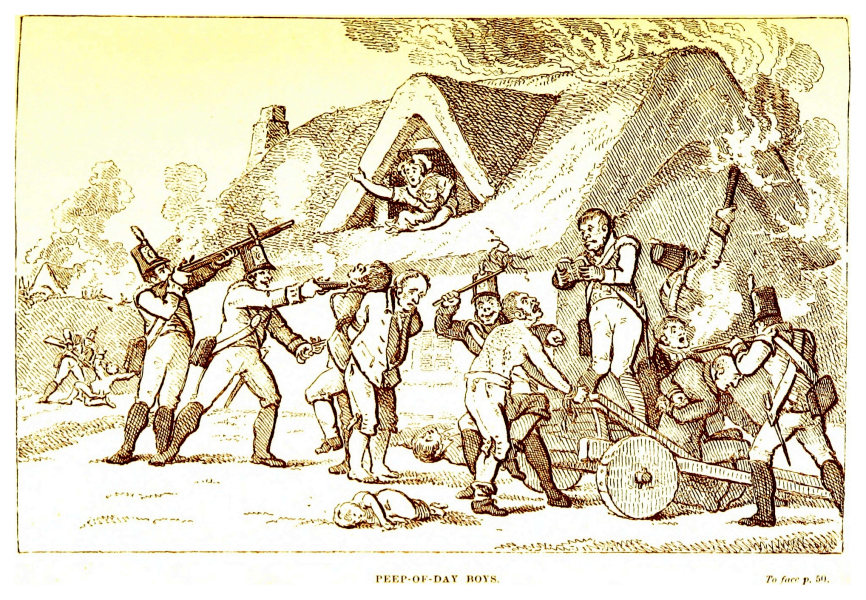
Peep-of-Day Boys’ from ‘Ireland in ’98: sketches of the principal men of the time, based upon the published volumes and some unpublished MSS. of the late Dr. R. R. Madden … Edited by J. B. Daly.’ London: Sonnenschein & Co, 1888.
IMAGE LINKED: wikimedia Attribution 4.0 International (CC BY 4.0)
In the wake of the Battle of the Diamond—which in reality was a fifteen-minute skirmish—Wilson, Winter, and Sloan resorted to form another society of men; this one exclusively for Protestants, who would be prepared to defend Protestant families from attack and persecution by the Roman Catholic ‘Defenders’.
This new organisation was called the Orange Society in fond memory of the Protestant King William of Orange; and because the men who created it were well-informed and active Freemasons, the organisation was formed into Lodges on the Masonic model, with a neo-Masonic degree system which included: modes of recognition; pass grips; and words. [4]
In years to come, the Orange Order would add a number of other neo-Masonic Orders including the Royal Arch Purple and the Royal Black Institution, which were clearly modelled on the Masonic Royal Arch, and Order of the Temple.
These additional Orders were seen by some Orangemen as elitist and a blatant attempt to make the Orange Order more Masonic-like, and were resisted by them for many years. They are now considered to be part of mainstream Orangeism.
This writer recalls the first time he saw a ‘Black Walk’ on television; he was well aware of ‘Orange Walks’ of course, but was surprised to see that on this occasion, in addition to the standard bowler hat, the ‘Blacks’ were wearing Masonic style aprons adorned with a Masonic square and compass. [5]
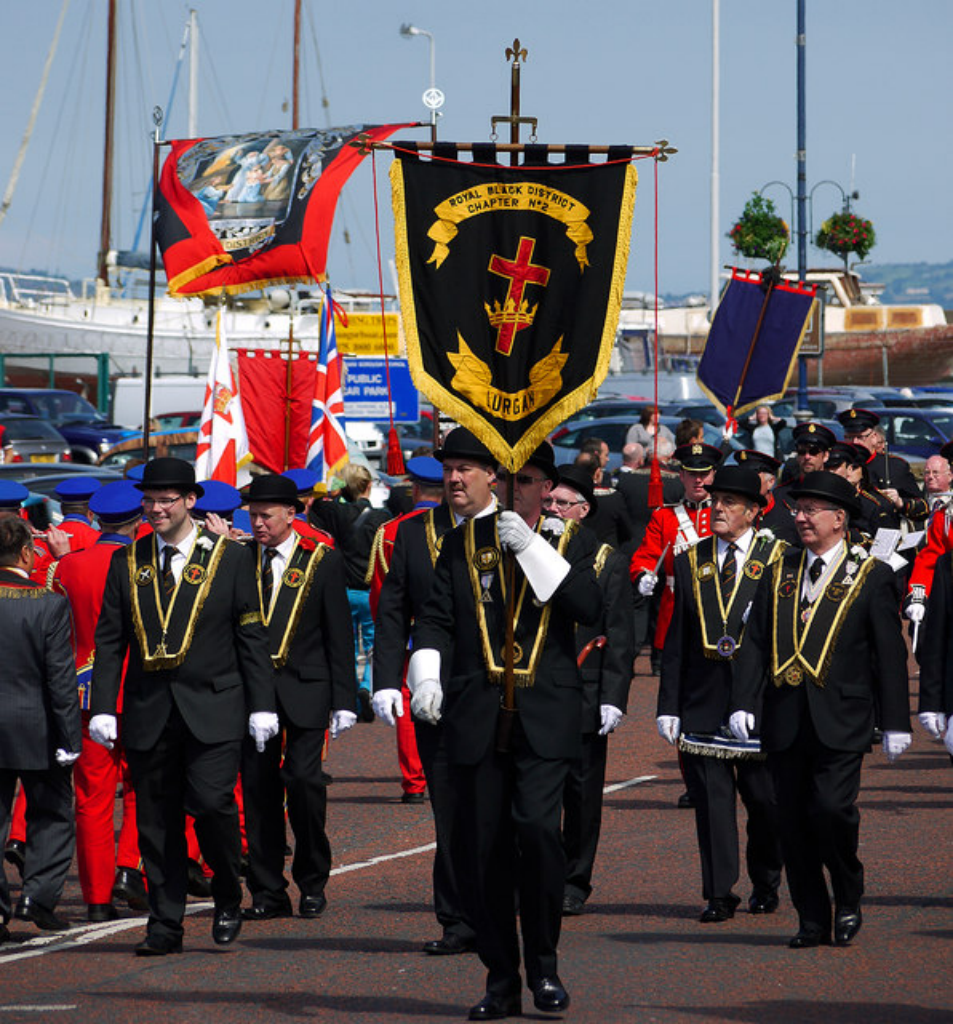
Royal Black Institution parade, Bangor.
IMAGE LINKED: wikimedia Attribution 4.0 International (CC BY 4.0)
Therefore, it appears that the fundamental difference between members of these Orders is, that a Freemason professes belief in an all-encompassing God; whereas, an Orangeman professes belief in a Protestant God and a Protestant God only.
Is there any reason to believe that Freemasonry over the years has been distinctly Protestant in character, such that it is not just the historical link and cosmetic likeness to Orangeism that leads people to believe this of it?
Certainly, a number of authors over the years have pointedly referred to Masonic Lodges as “Protestant sects” or an organisation for “middle class Protestants”. [6]
As Freemasons often suggest, perhaps the boot is on the other foot. There have been several Papal Bulls (edicts) issued by Popes over the years in which the Church of Rome makes clear its opposition to Freemasonry, and cautions their flock from joining so-called oath bound secret societies— which are not expressly their own oath bound secret societies.
Masonic scholar Jessica Harland-Jacobs makes this point when discussing the situation in Ireland during the early 19th century:” The hostile attitude of the Catholic Church—which was so obviously out of the control of Masonic authorities—contributed to Masonry’s increasingly Protestant character. [7]
She continues:
The priest’s actions against Freemasons were not the sole reason for Catholics’ departure from the [Masonic] fraternity.
Sometimes lodges with predominantly Protestant memberships either forced Catholic members out or prevented Catholics from joining in the first place.
For example, during the 1820s Lodge No. 424, in County Antrim, instituted a rule requiring members and candidates to swear they had never “professed the Roman Catholic religion” [8]
Although this state of affairs may have been a problem peculiar to Irish politics, the Irish diaspora over the years would transport the situation overseas to such places as the west of Scotland, North America, and Australia; where Orange and Masonic Lodges proliferated.
As Harland-Jacobs also notes:
In the highly sectarian atmosphere of the 1820s, the fate of Irish Freemasonry became intertwined with that most ardent champion of Protestant rights, the Orange Order’…Freemasonry’s growing identification with Orangeism—as evident in the issue of party processions— did not endear it to Catholics.
Contrary to the rules and principles of the Order, Masonic Lodges had begun associating publicly with the Orange Order by marching in Orange processions, wearing Orange ribbons on their Masonic aprons and playing Orange songs during their marches [9]
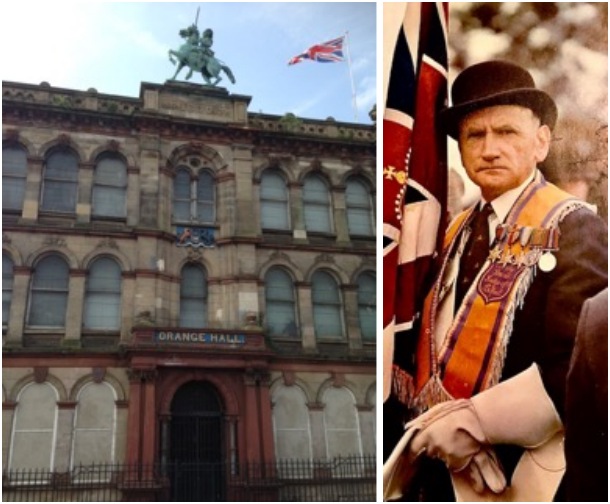
left: The Orange Hall, Clifton Street, Belfast
right: A stern looking Orangeman on parade
IMAGE CREDIT: author
The Masonic Grand Lodge of Ireland took a firm stance against this type of conduct and suspended a number of Lodges who engaged in it.
It was for these reasons, that an impression gained ground both in Ireland and further afield, that Freemasonry and Orangeism were indistinguishable- and distinctly Protestant in character. In recent times this perceived connection between Freemasonry and Orangeism has been played out publicly in Scotland. The Grand Lodge of Scotland website recently carried the following article which was originally published in The Sunday Times newspaper:
ETHICS CODE BANS POLICE
Police officers will be banned from joining the Orange Order under a new code of conduct to root out ‘unethical’ behaviour.
The Association of Chief Police Officers in Scotland (ACPOS) has drawn up a code of conduct that dictates how staff should behave on and off duty.
Under the charter, which is due to come into force later this year, officers will be warned not to join groups or engage in activities that could tarnish the reputation of their force, or leave them open to blackmail or accusations of impropriety.
Sources involved in drawing up the code say membership of sectarian groups such as the Orange Order and extreme political parties including the British National party will not be tolerated.
‘Attendance at social events, membership of organisations and affiliation to particular groups should not compromise (a police officer’s) position as a member of the Scottish Police Service in any way,’ the code states.
A source involved in drawing up the charter said: ‘There are some things that would raise eyebrows and call into question someone’s judgment, such as belonging to the Orange Order or a wife-swapping club. Some people will pick faults in this but the guidelines have to be broad and chief constables have to have some leeway.’
The policy follows concern over racism in the police service, highlighted by the BBC1 documentary The Secret Policeman, which showed racism among recruits at a training college.
However, the charter has sparked outrage among police officers, who claim it would undermine their human rights. Members of the Scottish Police Federation have claimed the code could be used to unfairly reprimand or discipline staff.
There is also concern among officers who are Freemasons that they could be targeted under the code.
The Orange Order has branded the code an affront to the organisation and the integrity of police officers in Scotland.
Ian Wilson, Grand Master of the Orange Order in Scotland, said he was appalled.
‘It’s political correctness taken to the nth degree. They are saying they do not trust their own members; that’s an absolute insult.’ [10]
The Grand Lodge of Scotland website responded thus to the emotive article:
This is becoming a constant refrain – that Freemasonry is in some way dubious. IT IS NOT! Scottish Freemasonry is a legal, legitimate organisation and repeated attempts to suggest that it is otherwise raise a number of important and fundamental issues of great concern.
The Grand Secretary, David M. Begg, wrote to the Editor of the Sunday Times, Les Snowdon, on 7th September pointing out that the article could confuse readers into believing that the Orange Order was in some way connected with Freemasonry.
The editor was invited to meet Grand Secretary in order to clarify this and other matters concerning Freemasonry. There has been no reply. [11]
The reply is suggestive of sensitivity in Scottish Masonic circles to any suggestion that the Masonic and Orange Orders are fraternal twins.
In contrast, Freemasons in the United States of America—at least historically— have often indicated their leanings towards the Protestant faith.
In a lecture on the subject of religious liberty, one Masonic lecturer discusses Martin Luther and his ‘protest’ against the Roman Catholic Church.
Other men protested as earnestly in other countries. Finally, the movement became widespread, and the domination of a single church was broken.
Protestantism broke the chains with which the Bible had been bound to church altars.
Protestantism taught men that the avenues which led to the Throne of God were open, and that every man might seek the divine aid in such manner as he saw fit.
Protestantism proclaimed the right of every man to set up his own altar when and where he pleased, and build the fires of reverence thereon. [12]
It also seems that as far as the cherished American Constitution was concerned, some Freemasons in America saw themselves as providing a similar function to those Orangemen who defended the Protestant Faith in Ireland.
In a speech entitled the ‘Book of Constitutions Guarded by the Tilers Sword’ the orator uses the proxy of an imaginary Lodge Tiler (Tyler) by the name of Peter to postulate his theory.
Peter indicates that because he spends most of his time outside the Lodge Room he has time to think more deeply about Masonic symbolism. He muses:
There is one of those emblems that has given me more trouble than anything else in Masonry; it is the one in which you see a book lying on a velvet pillow with a sword over the top.
The Master tells you it is the Book of Constitutions Guarded by the Tilers Sword and that it reminds us to be ever watchful and guarded in our thoughts, words, and actions, particularly when before the enemies of Masonry, ever bearing in mind those truly Masonic virtues, silence, and circumspection.
Now that never seemed just right to me. [13]
Peter goes on to consider that the great men who framed the Masonic ritual intended this symbol to have a deeper, greater meaning.
He goes on to agree with noted Masonic scholar Albert G. Mackey that the Book of Constitutions is a symbol of constituted law, and when guarded by the tiler’s sword, symbolises “Regard for and obedience to Law, a prominent Masonic duty.” [14]
Peter concludes:
So, until somebody shows me that I am wrong, I am given to believe every time I see that book and sword on the screen, that the book is the Constitution of the United States and the sword is Freemasonry on guard;
– and instead of teaching me to be watchful and guarded in all my thoughts, words, and actions, it is going to teach me to be ever watchful and guarded against the enemies of my nation and its constitution
– so that when I get into that Grand Lodge above those good old boys up there that built this nation are going to meet me with the Lions Paw,
– and vouch for me when the Supreme Grand Master of the Universe takes the Pass. [15]
Whilst admonishing the brethren to make up their own minds about what Peter has to say, the lecturer concludes his talk by saying that he is inclined to believe the ‘Old Tiler’.
Another noted American Masonic author Carl H. Claudy writing on the apparent contradictions in Freemasonry, has an old Past Master advising a young Master Mason on such contradictions. Some of the words could have come from the mouth of an Orangeman:
There is no Masonic reason why a Catholic cannot be a Freemason; the reason they cannot is because their Church forbids them to join oath-bound secret societies outside of their own.
Some Catholics in foreign countries have done so; honour the lodge broad-minded enough to receive them!
We do not receive them; we contend that a man owes his allegiance to where his faith is given;
– if a Catholic applies to us, knowing that his Church forbids it, it is evidence that he is ready to disobey where he has promised obedience.
Therefore, we don’t want him.
Masonry opposes the Catholic hierarchy. We defend American institutions from Papal encroachment. It is their organisation, their political ambitions we oppose; not that they choose to worship God in ways which are strange to us.
Masonry is not Christian. It is not Mohammedan. It is not Buddhistic. It is not any faith or creed.
Because some one Lodge or Grand Lodge declaims that it is, does not make it so.
Masonry does not contradict itself; Masons contradict themselves!
Men are not perfect. If they were, there would be no need of Masonry.
Masonry could not function in a perfect world of perfect men. There would be no use of a system of morality when all men were moral;
– no need of teaching anything by symbols or any other means if all men were wise.
But men are not perfect; they quarrel and disagree and take exceptions to each other’s ideas and beliefs.
But it is men, not the Masonry, which contradict!
Life is all a compromise, my brother. Practical Masonry is a compromise.
Never can we all be perfect. And one of the very greatest teachings of Masonry is toleration;
– toleration of the other fellow’s idea, his viewpoint, his belief.
When you are intolerant of these contradictions, you are yourself a contradiction of Masonic teachings.
If I taught you that Masonry contradicted herself, I would be a contradiction!
I will not contradict you! smiled the young Mason, unless you say I am not grateful. [16]
This writer will leave the final words on the subject with the wise old Past Master and his young protégé.
Footnotes
Reference
[1] Andrew SANDERS; ‘Football & Sectarianism: A Background Picture’ as reproduced in http://www.math.nus.edu.sg/aslaksen/glasgow.celtic.html.
[2] http://en.wikipedia.org/wiki/Brother_Walfrid
[3] http://www.grandlodgescotland.com/index.
[4] http://www.answers.com/topic/orange-institution;
[5] http://www.freewebs.com/bramptonlol5/royalblackinstitution.htm
[6] Kenneth Jack; ‘Freemasonry, Social Cohesion and Social Progress in 19th And 20th Century California’, in Masonic Magazine Issue 6, Winter (2006). In this article, the author quotes a number of writers who equate Freemasonry with Protestantism.
[7] Jessica L. Harland-Jacobs; Builders of Empire- Freemasonry and British Imperialism 1717-1927 The University of North Carolina Press, Chapel Hill, (2007) 153-156.
[8] Ibid.
[9]
[10] http://www.grandlodgescotland.com.
[11] Ibid.
[12] The Masonic Service Association of the United States, ‘Masonry and Americanism-Religious Liberty, Its Growth Meaning and Application’ as reproduced in the Little Masonic Library, Volume V, Macoy Publishing and Masonic Supply Company Inc. Richmond, Virginia, (1977) 161.
[13] The Masonic Service Association of the United States; ‘The Three Degrees and Great Symbols of Freemasonry-The Book of Constitutions Guarded by The Tilers Sword’- as reproduced in the Little Masonic Library, Volume IV, Macoy Publishing and Masonic Supply Company Inc. Richmond, Virginia, (1977) 242-245.
[14] Ibid.
[15] Ibid.
[16] The Masonic Service Association of the United States; ‘The Old Past Master- When Twice Two Is Five’ by Carl H Claudy- as reproduced in the Little Masonic Library, Volume V, Macoy Publishing and Masonic Supply Company Inc. Richmond, Virginia, (1977) 134-135.
Article by: Kenneth C. Jack
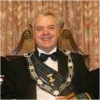
Kenneth C. Jack FPS is an enthusiastic Masonic researcher/writer from Highland Perthshire in Scotland.
He is Past Master of a Craft Lodge, Past First Principal of a Royal Arch Chapter, Past Most-Wise Sovereign of a Sovereign Chapter of Princes Rose Croix.
He has been extensively published in various Masonic periodicals throughout the world including: The Ashlar, The Square, The Scottish Rite Journal, Masonic Magazine, Philalethes Journal, and the annual transactions of various Masonic bodies.
Kenneth is a Fellow of the Philalethes Society, a highly prestigious Masonic research body based in the USA.

Builders of Empire – Freemasonry and British Imperialism 1717-1927
By:
Jessica L. Harland-Jacobs
They built some of the first communal structures on the empire’s frontiers. The empire’s most powerful proconsuls sought entrance into their lodges.
Their public rituals drew dense crowds from Montreal to Madras. The Ancient Free and Accepted Masons were quintessential builders of empire, argues Jessica Harland-Jacobs.
In this first study of the relationship between Freemasonry and British imperialism, Harland-Jacobs takes readers on a journey across two centuries and five continents, demonstrating that from the moment it left Britain’s shores, Freemasonry proved central to the building and cohesion of the British Empire.
The organization formally emerged in 1717 as a fraternity identified with the ideals of Enlightenment cosmopolitanism, such as universal brotherhood, sociability, tolerance, and benevolence.
As Freemasonry spread to Europe, the Americas, Asia, Australasia, and Africa, the group’s claims of cosmopolitan brotherhood were put to the test.
Harland-Jacobs examines the brotherhood’s role in diverse colonial settings and the impact of the empire on the brotherhood; in the process, she addresses issues of globalization, supranational identities, imperial power, fraternalism, and masculinity.
By tracking an important, identifiable institution across the wide chronological and geographical expanse of the British Empire, Builders of Empire makes a significant contribution to transnational history as well as the history of the Freemasons and imperial Britain.

The Orange Order
By: Eric P. Kaufmann
Based on unprecedented access to the Order’s internal documents, this book provides the first systematic social history of the Orange Order – the Protestant association dedicated to maintaining the British connection in Northern Ireland.
Kaufmann charts the Order’s path from the peak of its influence, in the early 1960s, to its present-day crisis. Along the way, he sketches a portrait of many of Orangeism’s leading figures, from ex-Prime Minister John Andrews to Ulster Unionist Party politicians like Martin Smyth, James Molyneaux, and David McNarry. Kaufmann also includes the highly revealing correspondence with adversaries such as Ian Paisley and David Trimble.
Packed with analyses of mass-membership trends and attitudes, the book also takes care to tell the story of the Order from ‘below’ as well as from above. In the process, it argues that the traditional Unionism of West Ulster is giving way to the more militant Unionism of Antrim and Belfast which is winning the hearts of the younger generation in cities and towns throughout the province.
Recent Articles: Kenneth C. Jack
 Observations on the History of Masonic Research Archaeology is often associated with uncovering ancient tombs and fossilized remains, but it goes beyond that. In a Masonic context, archaeology can be used to study and analyze the material culture of Freemasonry, providing insight into its history and development. This article will explore the emergence and evolution of Masonic research, shedding light on the challenges faced by this ancient society in the modern world. |
 Anthony O'Neal Haye – Freemason, Poet, Author and Magus Discover the untold story of Anthony O’Neal Haye, a revered Scottish Freemason and Poet Laureate of Lodge Canongate Kilwinning No. 2 in Edinburgh. Beyond his Masonic achievements, Haye was a prolific author, delving deep into the history of the Knights Templar and leaving an indelible mark on Scottish Freemasonry. Dive into the life of a man who, despite his humble beginnings, rose to prominence in both Masonic and literary circles, leaving a legacy that continues to inspire. |
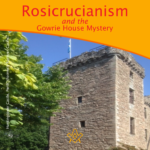 Rosicrucianism and the Gowrie House Mystery Unearth the mystifying intersections of Rosicrucianism and the infamous Gowrie House Mystery. Dive into speculative claims of sacred knowledge, royal theft, and a Masonic conspiracy, harking back to a fateful day in 1600. As we delve into this enthralling enigma, we challenge everything you thought you knew about this historical thriller. A paper by Kenneth Jack |
 Thomas Telford's Masonic Bridge of Dunkeld Of course, there is no such thing as a ‘Masonic Bridge’; but if any bridge is deserving of such an epithet, then the Bridge of Dunkeld is surely it. Designed by Scotsman Thomas Telford, one of the most famous Freemasons in history. |
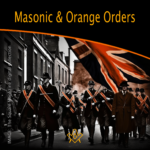 The masonic and orange orders: fraternal twins or public misperception? “Who’s the Mason in the black?” |
 Kenneth Jack's research reveals James Murray, 2nd Duke of Atholl – the 'lost Grand Master' |
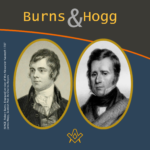 An Oration delivered to the Annual Burns and Hogg Festival, at Lodge Canongate Kilwinning, No. 2, Edinburgh, on 24 January 2018. By Bro. Kenneth C. Jack, FSAScot FPS, Past Master, Lodge St. Andrew, No. 814, Pitlochry. |
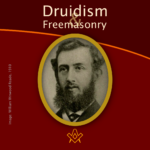 William Winwood Reade was a Scottish philosopher, historian, anthropologist, and explorer born in Crieff, Perthshire, Scotland. The following article by Kenneth Jack, provides some hints that William may have been a Freemason, but there is presently no definitive evidence he was. |
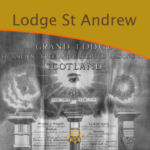 What's in a name? A brief history of the first Scottish Lodge in Australia - By Brother Kenneth C. Jack, Past Master, Lodge St. Andrew, No. 814, Pitlochry |
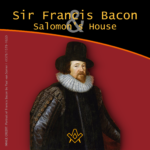 Sir Francis Bacon and Salomon’s House Does Sir Francis Bacon's book "The New Atlantis" indicate that he was a Rosicrucian, and most likely a Freemason too? Article by Kenneth Jack |
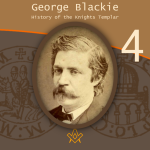 George Blackie – The History of the Knights Templar P.4 The final part in the serialisation of George Blackie's 'History of the Knights Templar and the Sublime Teachings of the Order' transcribed by Kenneth Jack. |
 George Blackie – The History of the Knights Templar P.3 Third part in the serialisation of George Blackie's 'History of the Knights Templar and the Sublime Teachings of the Order' transcribed by Kenneth Jack. |
 George Blackie – The History of the Knights Templar P.2 Second part in the serialisation of George Blackie's 'History of the Knights Templar and the Sublime Teachings of the Order' transcribed by Kenneth Jack. |
 George Blackie – The History of the Knights Templar P.1 First part in the serialisation of George Blackie's History of the Knights Templar and the Sublime Teachings of the Order – by Kenneth Jack |
 Little known as a Freemason, Bro Dr Robert ‘The Bulldog’ Irvine remains a Scottish rugby legend, and his feat of appearing in 10 consecutive international matches against England has only been surpassed once in 140 years by Sandy Carmichael. |
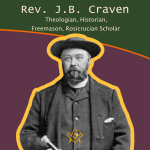 Rev. J.B. Craven: Theologian, Historian, Freemason, And Rosicrucian Scholar Archdeacon James Brown Craven is one of those unsung heroes of Scottish Freemasonry about whom very little has been previously written – here Kenneth Jack explores the life and works of this remarkable esoteric Christian. |
 Discover the powerful family of William Schaw, known as the 'Father of Freemasonry' |
 This month, Kenneth Jack invites us to look at the life of Sir William Peck; - astronomer, Freemason and inventor of the world's first electric car. A truly fascinating life story. |
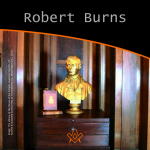 A Tribute to Scotland's Bard – The William Robertson Smith Collection With Burns' Night approaching, we pay tribute to Scotland's most famous Bard – The William Robertson Smith Collection |
 The Joy of Masonic Book Collecting Book purchasing and collecting is a great joy in its own right, but when a little extra something reveals itself on purchase; particularly with regards to older, rarer titles.. |
 Masons, Magus', and Monks of St Giles - who were the Birrell family of Scottish Freemasonry? |
 The 6th Duke of Atholl - Chieftain, Grand Master, and a Memorial to Remember In 1865, why did over 500 Scottish Freemasons climb a hill in Perthshire carrying working tools, corn, oil and wine? Author Kenneth Jack retraces their steps, and reveals all. |
 Charles Mackay: Freemason, Journalist, Writer Kenneth Jack looks at life of Bro Charles Mackay: Freemason, Journalist, Writer, Poet; and Author of ‘Tubal Cain’. |
 A Mother Lodge and a Connection Uncovered, a claim that Sir Robert Moray was the first speculative Freemason to be initiated on English soil. |
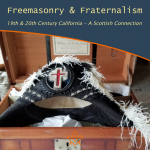 What is it that connects a very old, well-known Crieff family, with a former President of the United States of America? |
 The life of Bro. Cattanach, a theosophist occultist and Scottish Freemason |
 The Mysterious Walled Garden of Edzell Castle Explore the mysterious walled garden steeped in Freemasonry, Rosicrucianism, and Hermeticism. |
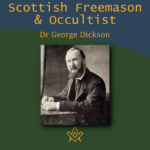 Dr. George Dickson: Scottish Freemason and Occultist Bro. Kenneth explores the life of Dr George Dickson a Scottish Freemason and Occultist |
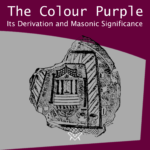 The Colour Purple - Its Derivation and Masonic Significance What is the colour purple with regards to Freemasonry? The colour is certainly significant within the Royal Arch series of degrees being emblematical of Union. |
 Bridging the Mainstream and the Fringe Edward MacBean bridging mainstream Freemasonry with the fringe esoteric branches of Freemasonry |
 Freemasonry in the Works of John Steinbeck We examine Freemasonry in the Works of John Steinbeck |
 Renegade Scottish Freemason - John Crombie Who was John Crombie and why was he a 'renegade'? |
 Scottish Witchcraft And The Third Degree How is Witchcraft connected to the Scottish Third Degree |
masonic knowledge
to be a better citizen of the world
share the square with two brothers

click image to open email app on mobile device



